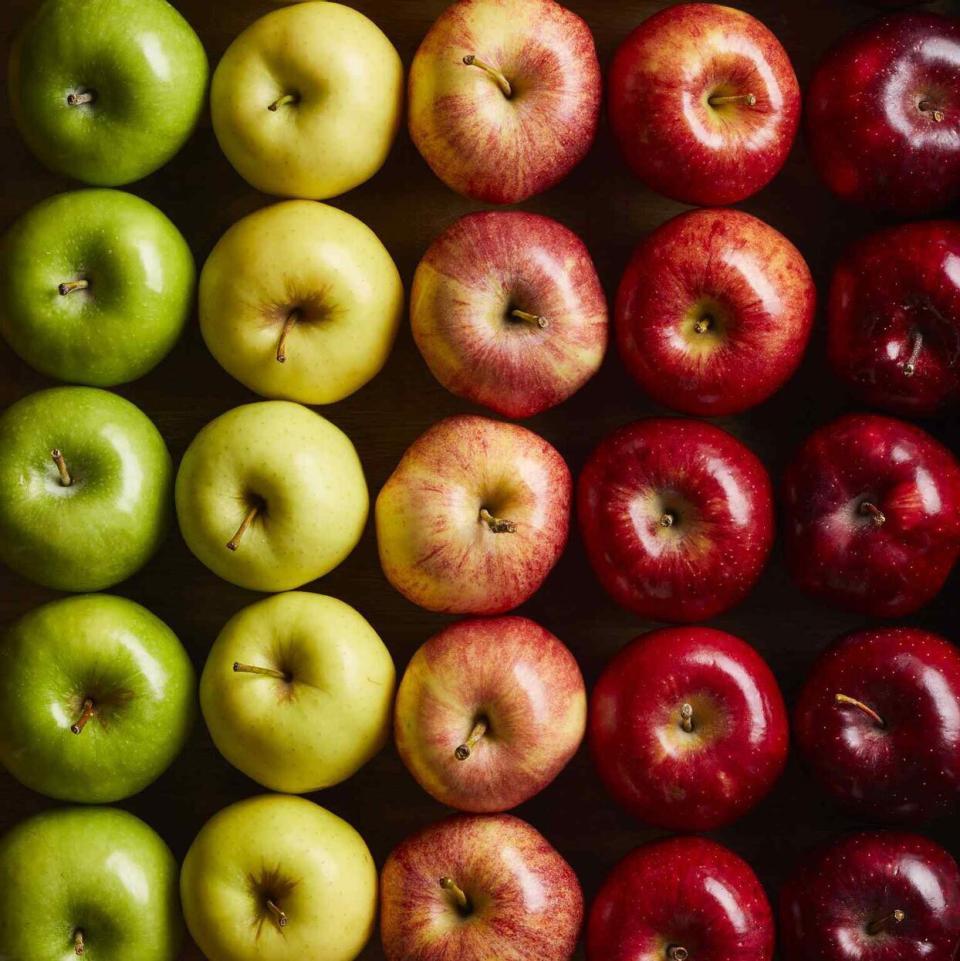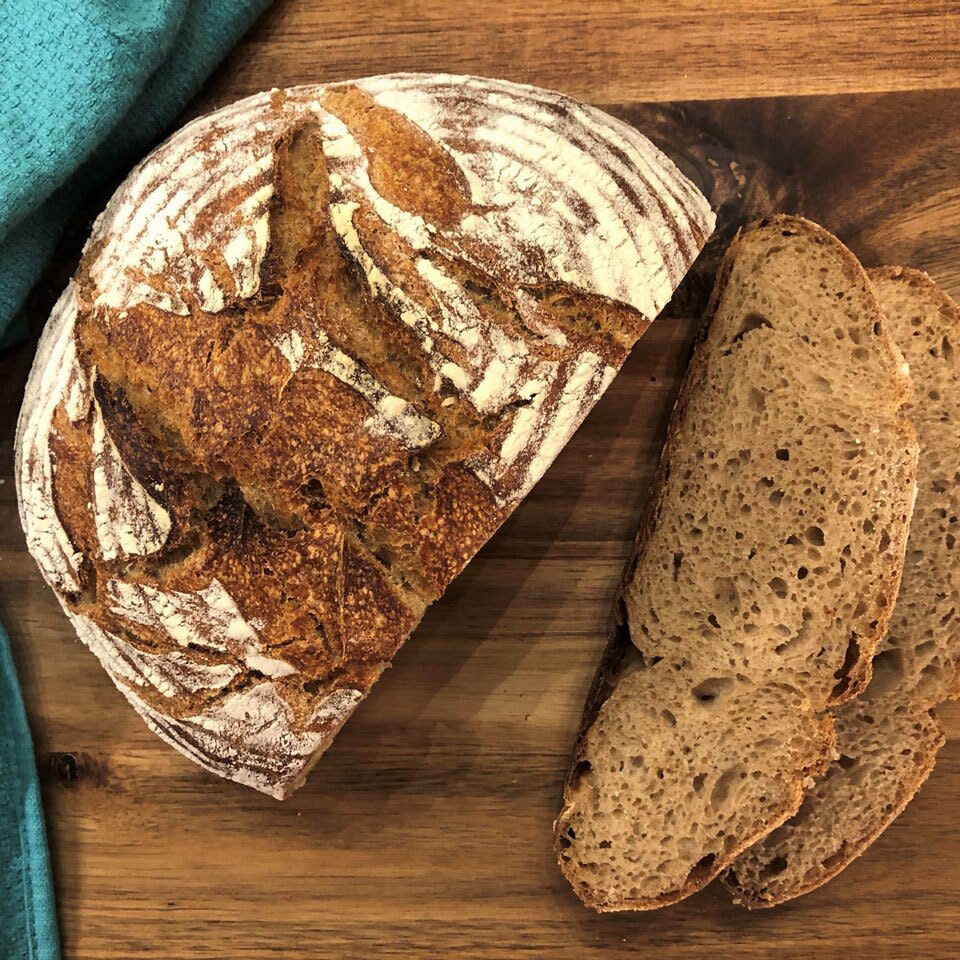Everything About Nutrition We Wish We Had Learned 30 Years Ago

- Oops!Something went wrong.Please try again later.
Getty Images
Back in the 90's, EatingWell debuted what would become a tradition for several years: a "State of the Plate" article that looked at a year's Most memorable moments in food and nutrition—the good, the bad and the just plain bizarre. As part of our anniversary celebration, we're bringing back that tradition, with a twist: in addition to delving into today's culinary landscape, we're contrasting it with where it was three decades ago. The perspective is both eye-opening and, in some cases, cringey.
Thirty years ago, cooking and eating low-fat to keep our hearts—and waist-lines—healthy was on everyone's mind, including ours. (Some of our early baked-good recipes called for replacing fats like butter and oil with prune puree, tofu and baby food. See? Cringe.) But EatingWell was also coming to embrace the idea of keeping good-for-you fats in and trans fats out. We gave rock-star status to fare like spinach, blueberries and tea, and called out bad actors like fast-food chains pushing supersized fries and restaurants serving 48-ounce steaks. We pointed out the risks tied to the rise of soda consumption and newfangled sweetened upscale coffee drinks.
While the word "clickbait" had yet to be invented, we encouraged readers to look beyond the glowing headlines on things like therapeutic herbs and red wine, to seek credible science and a more nuanced read. And then, as now, we kept our eye on the future, always looking for new ways to help readers make informed decisions about what they ate and drank.
One thing that hasn't changed: you, our readers, who have always been curious, well-informed and adventurous; skeptical of quick fixes and fad diets, yet open-minded to evolving research. We connect with you now more than we ever have, and welcome your ideas and feedback in all the channels in which you'll find us. Here's to the next 30 years!
Three Decades of Food Milestones
Several things have changed over the last 30 years. Here are some of the notable food trends from 1990 until now.
1990: In September, EatingWell, "The Magazine of Food and Health," launches from a drafty, repurposed warehouse in rural Charlotte, Vermont.
Food labels actually mean something: the Nutrition Labeling and Education Act passes, requiring standardized nutrition labels on most food packages.
1992: King Arthur introduces white whole-wheat flour, enabling bakers (and Eating Well Test Kitchen staffers) to make their whole-grain baking less ... earnest.
The United States Department of Agriculture releases the Food Guide Pyramid, visually confirming nation-wide carb domination.
SnackWell's low-fat cookies are introduced and fly off shelves. Later, the "SnackWell's effect" becomes shorthand for all that is wrong with the low-fat, high-carb diet fad
1993: Chipotle Mexican Grill is founded in Denver—marking the beginning of the "fast casual" restaurant category.
The TV Food Network (now the Food Network) premieres, elevating chefs like Bobby Flay to A-list celeb status.
1994: The Food and Drug Administration approves the first genetically modified food, the long-shelf-lived Flavr Savr tomato—followed a year later by GMO canola, corn, soybeans and squash—sparking the anti-GMO movement.
1996: The FDA approves Olestra, a fat-free fat substitute with the unfortunate side effect of inducing "anal leakage." Lay's WOW! potato chips made with Olestras sport a warning label. (While it's no longer used in snack foods, Olestra found new life as an industrial lubricant.)
1998: Sucralose, a "made from sugar" noncaloric sweetener, is introduced. The obesity rate is not impressed.
2002: Low-carb guru Robert Atkins, M.D., releases Dr. Atkins' New Diet Revolution, reawakening the breadbasket shame people felt 30 years earlier, when his first Diet Revolution was published.
In other news: Organic labels finally have teeth. The USDA National Organic Program's "Certified Organic" labeling rules— some 12 years in the making—go into effect.
2003: "Fermentation fetishist" Sandor Katz publishes Wild Fermentation, inspiring millions of sauerkraut, kimchi, kombucha and sourdough enthusiasts.
2004: Facebook arrives, enabling you to share what you had for breakfast with 1,000 of your closest friends.
2006: In April, Michael Pollan releases The Omnivore's Dilemma, making terms like food system, high-fructose corn syrup and CAFO household words.
2008: Chobani launches and the cult of Greek yogurt begins. OurTest Kitchen rejoices at no longer having to strain regular yogurt through a coffee filter to make it.
And in a recession-driven effort to cut costs, Los Angeles chef Roy Choi rolls out his Kogi BBQ truck. The food-truck era is born.
2009: The White House Kitchen Garden is planted in March; interest in vegetables and sustainable eating skyrockets.
Gluten-free foods become A Thing, with $1.56 billion in U.S. sales—and projections of continuing breakneck growth.
2010: Welcome, Instant Pot!
2011: In June, the USDA replaces the Pyramid guide with MyPlate where vegetables and fruits fill half the dish and nudge grains to a smaller portion. First Lady Michelle Obama announces it.
Instagram arrives.
2012: Blue Apron and Plated meal-kit delivery services kick off, making "home cook- ing" as easy as opening a box.
2013: Jay-Z announces he's doing a 22-day vegan challenge, with a P.S. that "B is also joining me." Veganism officially becomes cool.
2016: Restaurant delivery services go mainstream: 51% of Americans report using apps like GrubHub and DoorDash to purchase meals from casual dining outlets, with 26% ordering at least weekly.
2017: The Regenerative Organic Alliance releases its Regenerative Organic Certification program, which incorporates soil health, animal welfare and social justice in its eligibility criteria.
2018: Plant-based milk sales have exploded—growing 61% in the past 5 years.
2019: The EAT-Lancet Commission releases its Food in the Anthropocene report in January, linking our red meat- and sugar-heavy diets to climate change, and recommending we slash our consumption and eat more plant-based foods.
2020: COVID-19 sweeps the world. Many Americans line up for miles at food distribution sites. Restaurants shutter or pivot to takeout models; farms teeter. Yet perseverance is everywhere: chefs, nonprofits, entire communities find ways to offer hope—and nourishing food.

This Man Is Helping
We've learned a lot from Walter Willett, M.D., Dr.P.H., over the years, and so have our readers. A professor of epidemiology and nutrition at Harvard's T.H. Chan School of Public Health, his research (more than 1,700 published studies) has examined critical nutrition issues—from the impact of sugary drinks on heart health to obesity's role in cancer risk—and he's still our go-to for solid, science-backed nutrition wisdom.
Willett has also played a key role in shaping nutrition policy for the better. Last year he was a lead author on the EAT-Lancet Commission on Food, Planet, Health report that urged, among other things, reducing our meat intake significantly—for both human and environmental health. But perhaps he's best known as the man whose research and tireless advocacy helped get trans fats out of our food supply. We named Willett "Nutrition Educator of the Year" in our first "State of the Plate" feature (as well as one of our American Food Heroes in 2018) and recently checked back with him on the changes he's seen over the past 30 years—and the ones he sees ahead.
Question: For decades, one of your main goals was to get trans fats out of our food. Now, they're pretty much gone. What have you learned from that success?
Answer: That the pathway from scientific evidence to policy is a very indirect, meandering path, with lots of obstacles. And just because the evidence is there doesn't mean it's going to be acted upon automatically, or that policymakers will follow through. The change really happened from the grassroots up, rather than policy from top down. It took getting the word out to the public to make it happen.
Question: What are the most critical public health challenges you see today, nutrition-wise?
Answer: Overall diet quality is still very poor, and the most visible aspect of this is the obesity epidemic. Five or six years ago, it looked like it might be plateauing off, but now it's clearly continuing up with a vengeance. The latest data are showing that 42% of American adults are obese, which is astounding. In the early 1970s it was 10%. We're starting to see a reverse in a lot of the gains that had been achieved with so much hard work over 50 years. And it's clearly, strongly, related to income. We can really connect the dots between poverty and poor diet quality, obesity, diabetes, diabetes mortality and now COVID-19. Obesity, and the consequences of it, are the major factors (apart from age) that are related to people dying from the virus.
Part of the U.S. population is doing very well—the part that has access to knowledge and the ability to act upon it; we see them shopping at health food stores and running along the river. They are getting healthier and living longer. But the other part of the population is stuck, and getting worse in terms of obesity. So the gap is growing.
I think there will be a greater shift toward plant-forward diets. More people are realizing that the consequences of our current animal-centric diets are disastrous for planetary health and future generations, as well as being unhealthy for us today.
—Walter Willett, M.D., Dr.P.H.
Question: What do you see on the horizon for American eating habits?
Answer: I think there will be a greater shift toward plant-forward diets. More people are realizing that the consequences of our current animal-centric diets are disastrous for planetary health and future generations, as well as being unhealthy for us today. More people are realizing that we need to change our national leadership to help get us on a track leading toward a sustainable and healthy future. This gives me some hope.
The Diet We've Loved Since Day 1: Mediterranean
EatingWell launched around the same time that the Mediterranean Diet was gaining national popularity—and we, too, were beguiled by this olive-oil-drizzled, plant-centric way of eating. It was a revelation to learn that people who ate this way (namely, Greeks living on the island of Crete) had healthier hearts, lived longer and just seemed to enjoy life more than those of us nibbling fat-free cookies and spending our free time doing Buns of Steel.
Over the decades, our love for the Med diet has only grown, and so has the world's. We've featured hundreds of Mediterranean-focused recipes, and devoted multiple issues entirely to this style of eating. And, like a nutritional Meryl Streep, the Mediterranean Diet has continued to win with nutrition experts—including a recent three-peat as best overall diet from U.S. News & World Report—while amassing a pile of research linking it with better heart and brain health and lower rates of diabetes and some cancers. Best of all, eating a traditional Mediterranean diet is just plain delicious and epitomizes the EatingWell approach of putting flavor and health first. Kalí órexi!
What The Future May Look Like
We've made lots of guesses at the Next Big Thing in Food over the years. Energy bars, for example. In the '90s, we pointed to their fast-growing sales as a sign of It-dom—and today, the $3 billion energy bar category is expected to grow another $1.4 billion in the next three years. Likewise, we predicted dairy-free milk was going to take off. And you've seen the "dairy" aisle at the supermarket recently, right? OK, our vision that broccoli rabe would become all the rage has yet to come true (although we still love it). But we're going to go out on a limb and call out three food trends we see coming now. May future history prove us right.
Designer produce will explode

We'll see more and more varieties of "branded" produce bred for richer flavor and textures, rather than for shelf life or picture-perfect beauty—for example, new apple hybrids like ultra-juicy Cosmic Crisp and bite-size Rockit, or the deliciously sweet Butternut 661 squash from the Row 7 seed company.
Home cooking will continue its surge

While the pandemic may have sent us back to our kitchens, larger numbers of us will want to keep experimenting with new ideas, foods and recipes—beyond sourdough. And thanks to technology, we'll have access to experts in regions and cultures around the world, and hyperlocal "micro" cuisines that allow us to explore even more types of dishes.
Dieting will be done for good

Getty / Tim Robberts
We'll finally wake up to the fact that following a regimen of temporary deprivation to achieve a health or aesthetic goal is an exercise in futility—and that healthy eating for life is about building ongoing habits, not quick fixes.

